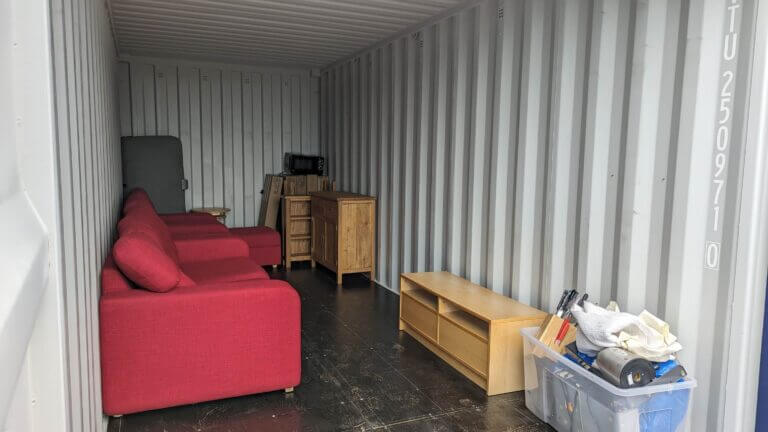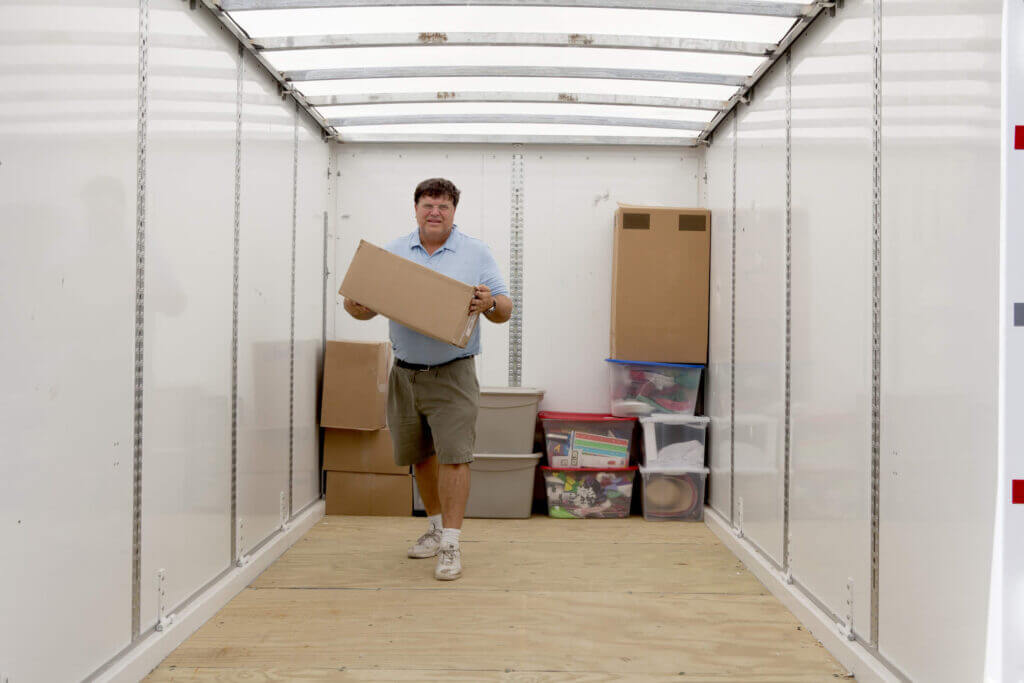Properly storing furniture in a storage unit is essential to maintaining its condition and preventing damage from moisture, dust, mold, and other environmental factors. Whether you are relocating, downsizing, or needing extra space, following these storage unit tips will help arrange your inventory in an organized way, keeping it safe from dirt and ensuring easy access to your belongings. With various locations available, choosing the right one is crucial to protecting your things because when it comes to storage, not just anything will do.
McDowell Mountain Community Storage provides a secure and well-maintained self-storage facility with various storage unit size guide options to meet your needs. Whether you need to move a single item or store multiple materials, we offer solutions for every type of furniture. This guide will walk you through the best ways to prepare, pack, and label your belongings, ensuring they remain in excellent condition throughout their storage. We aim to help customers protect their valuables while maximizing their storage areas for better accessibility and organization.
Why Proper Furniture Storage Matters
Storing furniture improperly can lead to various issues, including:
- Mold Growth and Mildew: Caused by high humidity levels, which can ruin fabric, wood, and leather.
- Pests and Infestations: Rodents and insects can nest in sofas, mattresses, and wood furniture.
- Scratches and Dents: Poor stacking and lack of proper padding can result in surface damage.
- Structural Warping: Excessive exposure to extreme temperatures and humidity can alter the shape of wooden pieces.
By taking preventive steps, you can organize your furniture correctly and ensure that it remains in excellent condition while in storage, protecting it from environmental factors and preserving its material quality.
Step 1: Choosing the Right Storage Unit
Selecting an appropriate storage unit is the first step to keeping your items safe. Consider the following factors:
1. Climate Controlled vs. Standard Storage
A climate-controlled storage unit is highly recommended, especially for valuable furniture pieces. It helps maintain stable humidity levels and protects against temperature fluctuations that can lead to mildew, stains, and warping. This option is ideal for businesses and individuals seeking a secure self-storage solution. Choosing the right location is crucial to minimizing exposure to debris and environmental damage. Extra precautions can go a long way in preserving your furniture, ensuring it stays in top condition while respecting your rights as a storage user.
However, if you choose a standard storage unit, ensure proper ventilation, air circulation, and additional protection like plastic or cardboard coverings. Protective materials like furniture blankets can help prevent scratches and dust buildup. Wrapping delicate items like mirrors and glass furniture securely in a padded box will add extra protection and maintain their value over time.
2. Storage Unit Size Guide
Understanding the right storage unit size guide is essential for efficient organization. A well-planned self storage unit protects items from heat and ensures easy access through the door. Many facilities offer an app to track fees, making storage in your town more convenient. The main reason for choosing the right unit is to keep your belongings safe and organized. Here’s a breakdown of shared storage unit sizes:
- 5×5 Unit – Suitable for small boxes, a few chairs, or a dresser.
- 5×10 Unit – Ideal for a small apartment’s worth of furniture, such as a sofa, table, and mattress.
- 10×10 Unit – Fits several pieces like a couch, bed frames, and bookshelves.
- 10×20 Unit – Best for home furniture, including sofas, tables, chairs, and storage supplies.
Consider the space needed for walkways to ensure easy access to your belongings.
Step 2: Preparing Furniture for Storage
Proper preparation is key to preventing damage and maintaining the lifespan of your furniture item. Different types of materials require specific care to preserve their appearance. With the right approach, you can ensure a better storage experience and keep your belongings in excellent condition. These steps will help protect your furniture for the long term.
1. Clean Everything Thoroughly
Before moving your items into a storage unit, clean all surfaces using:
- Soap and Water – Ideal for wood and hard materials.
- Upholstery Cleaner – For fabric and leather furniture.
- Leather Conditioner – Helps protect sofas, chairs, and couches from drying out.
Allow everything to dry completely to prevent mold growth and mildew.
2. Disassemble Large Furniture Pieces
Taking apart larger items will help maximize storage space and minimize the risk of scratches or dents.
- Remove table legs, bed frames, and bookshelves.
- Store screws, bolts, and nuts in a labeled bag.
- Keep all hardware with the corresponding furniture piece.
3. Protect Your Furniture with the Right Materials
Use blankets, bubble wrap, and plastic covers to protect furniture surfaces. Additional packing supplies include:
- Cardboard Sheets – Helps prevent scratches and stains.
- Padding and Tape – Secures fragile edges and corners.
- Sheets and Cloth – Keeps dust from accumulating on sofas and tables.
Step 3: Organizing Furniture in a Storage Unit
Once your items are packed, arranging them correctly inside the unit is crucial.
1. Place Heavier Items at the Back
Position bulky pieces like sofas, dressers, and mattresses at the Back of the unit to create a stable base.
2. Stack Smartly
- Use pallets or cinder blocks to elevate furniture off the floor.
- Place lighter items on top of heavier ones.
- Avoid overstacking to prevent damage to fragile materials.
3. Leave a Walkway for Easy Access
An open walkway will make accessing stored items easier without unnecessary transportation or rearranging. Using furniture covers can help protect pieces while maximizing room efficiency. Properly planning storage also ensures better organization and can even reduce rental rates in the long run.
4. Maintain Air Circulation
Proper air circulation prevents humidity buildup, reducing the risk of mold growth and moisture damage. One of the main reasons to allow airflow is to protect valuable possessions in your self-storage unit. Avoid pushing furniture directly against walls for better ventilation, ensuring both men’s and women’s customers keep their items in top condition.
Step 4: Long-Term Storage Care

Trust McDowell Mountain Community Storage for secure and reliable storage solutions to keep your furniture in good condition over time. Our facility offers the ideal environment to protect your belongings from moisture, dust, and damage. Follow these additional steps:
1. Check Your Storage Unit Regularly
Make it a habit to inspect your unit for pests, mold, and any damage. If you notice humidity issues, use a dehumidifier to maintain stable temperatures. Checking for spills and ensuring items are not pressed against the wall can help prevent moisture buildup. Regular inspections provide long-term benefits by keeping your belongings in the best condition.
2. Cover Items with Fabric, Not Plastic
While plastic covers can protect against water, they can trap moisture, leading to mildew. Instead, use cloth, sheets, or breathable covers.
3. Protect Against Pests
Rodents and insects can be a significant risk in storage facilities. Use:
- Pest-Repellent Bags – Store clothing, fabric, and mattresses safely.
- Sealed Plastic Containers – Prevent insects from accessing storage supplies.
Final Thoughts on Storing Furniture in a Storage Unit
Proper furniture storage requires careful planning, from choosing the right storage unit size guide to using the correct materials for protection. Following these storage unit tips ensures your belongings remain in excellent condition while in self-storage.
Looking for a reliable storage facility? McDowell Mountain Community Storage offers secure storage units with climate control and various options to fit your needs. Whether you’re storing sofas, tables, or an entire home’s worth of furniture, our facilities provide the best conditions for long-term storage.
For more information, visit our sitemap, check out our menu of services, or contact us for a personalized storage solution!
Frequently Asked Questions
1. How long can furniture be stored in a storage unit?
Furniture can be stored in a storage unit for as long as needed, provided it is adequately prepared and protected. Climate-controlled units are best for long-term storage to prevent humidity-related damage like mold or warping. Regularly checking your items and maintaining good air circulation can help preserve their condition.
2. What are the best storage solutions for antique or delicate furniture?
Antique and delicate furniture should be stored in a climate-controlled storage unit to prevent temperature fluctuations and humidity damage. Furniture blankets, bubble wrap, and cloth covers should protect surfaces. Fragile items like mirrors or glass doors should be wrapped in padding and stored upright to prevent breakage.
3. Can I store outdoor furniture in a storage unit?
Yes, outdoor furniture can be stored, but it must be cleaned and dried first to prevent mold and rust. Plastic covers can help protect against dust, while breathable fabric covers prevent moisture buildup. Elevating items off the floor with pallets or cinder blocks can protect them from water or dirt.
4. Are there any restrictions on what type of furniture can be stored?
Most standard furniture can be stored in a unit, but flammable, hazardous, or perishable items are prohibited. This includes furniture treated with chemicals that could release harmful fumes. Check with McDowell Mountain Community Storage for any restrictions before storing your furniture.
5. How do I prevent my furniture from smelling musty in storage?
Ensure the furniture is completely dry before storing it to prevent musty odors. Use charcoal bags or moisture absorbers to help control humidity. Keeping furniture slightly elevated and leaving a small gap between items can improve air circulation and reduce odor buildup.
6. Should I use a professional moving service to transport my furniture to storage?
If you have large or heavy furniture, hiring a professional moving service can help prevent damage during transportation. Movers can properly disassemble, wrap, and secure furniture, reducing the risk of scratches, dents, or breakage. If moving items yourself, use moving blankets, straps, and a dolly for safety.
7. How do I store furniture with glass components safely?
Glass tabletops, doors, and mirrors should be wrapped in bubble wrap and secured in a box or padded cover. To prevent breakage, always store glass items vertically, never flat. Label them as fragile and place them in a low-traffic area of your storage unit.
8. Is insurance necessary for stored furniture?
While not required, storage insurance is highly recommended, especially for valuable or antique furniture. Many storage facilities offer insurance plans, or you can check if your homeowners’ or renters’ insurance covers storage units.
9. How do I keep rodents and insects away from my furniture in storage?
To prevent pests, store furniture in a clean, dry storage unit. Use sealed plastic containers for small items, and avoid storing food or scented products. Placing pest-repellent bags or traps inside the unit can help keep insects and rodents away.
10. What should I do if I need to retrieve an item from storage quickly?
Label all boxes and furniture pieces clearly and keep an inventory list to make retrieval easy. Arrange furniture so that there is a walkway for easy access. Place frequently used items near the front of the unit so you can grab them without moving everything around.


